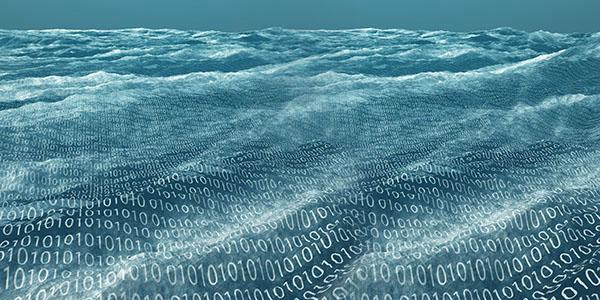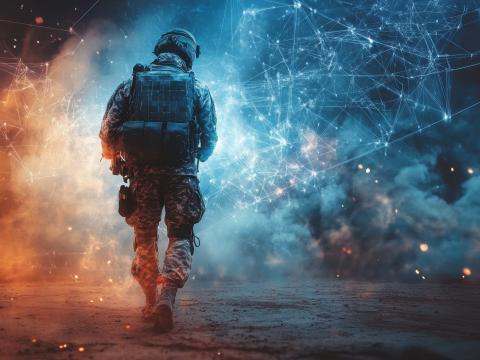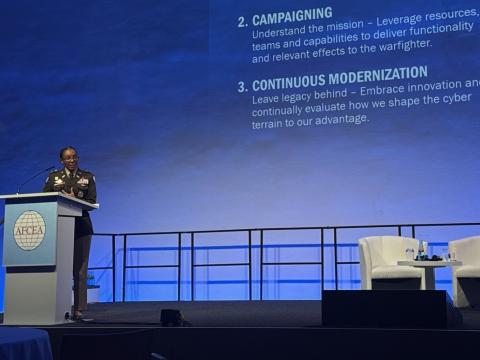Navy Sets Sail With Big Data
Part of the Office of Naval Research’s efforts in command, control, communications and computers is to provide key analytical tools to planners, analysts and commanders swamped by data. To that end, the office, known as the ONR, is conducting basic and applied research in applications that will cut maneuver planning time, expand access to data, enhance analytical processing and improve predictions. The tools are meant to improve decision making across antisubmarine warfare, integrated air and missile defense, electromagnetic maneuver warfare, and expeditionary and integrated fires missions.
These efforts support several programs in the Mathematics, Computer and Information Sciences Division in the ONR’s Command, Control, Communications, Computers, Intelligence, Surveillance and Reconnaissance Department, also known as Code 31. Cmdr. William “Kip” Krebs, USNR, ONR program officer, oversees several programs in the division. He has been involved with the laboratory since the early 1990s, first as a Medical Service Corps officer in the Navy after graduate school, working in a lab performing science and technology research, and then as a civilian for the past 12 years.
His division is helping to provide new command and control capabilities to both the U.S. Navy and Marine Corps, including intelligence products and big data analytics. “It’s a whole spectrum of capabilities for the submarine force, the surface force, on shore or air,” Cmdr. Krebs says. When combined with related efforts from other ONR programs, these modern capabilities are one way the Navy is working to strengthen cyber warfighting.
One such research program is the Data Focus Naval Tactical Cloud, which began in fiscal year 2015 and runs through FY2019. Code 31’s applied research and advanced development for this endeavor that is part of the Future Naval Capabilities program incorporates big data technologies and advanced analytics to improve operational, intelligence and tactical decisions. As part of this research, the ONR is working with the Battlespace Awareness and Information Operations Program Office, PMW-120, in the Navy’s Program Executive Office Command, Control, Communications, Computers and Intelligence (PEO C4I). The data science they are developing will enhance assessments of predictive enemy courses of action and intentions. The tools will aid in pulling out new and deeper insights to beef up the Navy’s operational intelligence across various sea, land and air missions. The work also will help the Navy transition to the PEO C4I’s Distributed Common Ground System-Navy Increment 2 capabilities.
An offshoot of another program being developed for theater antisubmarine warfare will improve upon a strategy known as farthest on circle, or FOC. “Predominately geared toward transitioning to PMW-120, it is a part of the PEO C4I’s D-6 intelligence data-gathering capabilities,” Cmdr. Krebs allows.
Currently, when a person of interest or a contact needs to be located, analysts use mathematical calculations of maximum ship speed over time to determine an area or FOC to search. “Let’s say that I want to know about a contact, and I want to know where that contact is located at any given time,” Cmdr. Krebs states. “Then I get some information that the contact departs a port on a ship on this day, and I can then say, ‘I know this ship can travel at a certain maximum speed, and over a 24-hour period the distance would be X.’ But over a couple of day period, you can imagine that farthest on circle gets pretty big, and the location of that contact gets even more uncertain.”
With the Data Focus Naval Tactical Cloud program, ONR researchers are using machine learning and big data, including historical, current, and classified and unclassified intelligence data—“a host of different types of data sources,” Cmdr. Krebs offers—to come up with a better prediction of where that contact might be. They employ a natural language processor and algorithms, along with various forms of data that include web sources and chat logs, to extract certain keywords or pieces of information to help the Navy understand where someone might be located.
For the algorithms, the Navy is using a variety of approaches “from a number of companies,” Cmdr. Krebs shares. That includes the Integrated Long-term Recursive Tracker (I-LRT) tool from Metron Scientific Solutions Incorporated, a mathematical optimization company in Reston, Virginia. (See Using Statistics to Conduct More Efficient Searches.)
While algorithms can be improved over time, Cmdr. Krebs stresses that “the challenge with any of these algorithms, with machine learning, neural networks and any statistical processing, is that it boils down to the actual data and the quality of the data.” Another issue he identifies is getting access to the data where and when it is needed. Unfortunately, the initial digital migration within Navy systems resulted in silos of data with different formats. “Like many organizations that transitioned from paper products to computer systems, no one really thought about it holistically,” Cmdr. Krebs acknowledges. “Each one of the organizations chose a different path of how to integrate that information, present it and how to store it.
“All this data is out there, but there is not a single ability to tap into that data,” he laments. “That is one of the biggest challenges of being able to apply these different statistical machine learning algorithms and processing.”
The ONR is building off of a previous effort called the Tactical Reference Infrastructure that created the necessary foundation to hold and organize data, Cmdr. Krebs says. The Data Focus Naval Tactical Cloud program aims to provide “unprecedented” access to data and offer “more powerful computation capabilities to enable a greater span of command and control optimization,” according to the ONR. It will expand data access from the current unit level to group and force levels. It also will add more storage for historical and predictive data to ships afloat and provide more powerful analytical tools for predictive data.
Meanwhile, two other Code 31 efforts, the Multi-Objective Optimization and Resource Optimization programs, are focused squarely on improving decision making by optimizing tactical decision aids, Cmdr. Krebs offers. Users have a “whole bunch of tactical decision aids available to help them,” he says, such as shallow water tables, sun and moon charts, identified hazards and threat locations. Overlaying all this digital information can overwhelm the user, Cmdr. Krebs says. “The multi-objective optimization then takes all this data and the tactical decision aids in and structures it within the user’s workflow to see what the decision is you are trying to come up with. It creates an optimization algorithm that will then help a decision maker understand the courses of action.”
For example, when preparing maneuvers off the coast of Florida, route planners have to balance oil rigs, ships, sailboats and marine life, among many factors. The multi-objective optimization tool can take into account the most likely route, say, of dolphins migrating to the area while incorporating all the other considerations and pieces of information, Cmdr. Krebs explains.
The tool also can be tailored for novice or expert users, who may be more discerning and want to know “certain parameters of the user interface as to why the tactical decision aid provided a certain response,” he says.
Another related effort is the ONR’s Operational Planning Tool (OPT), which is being developed for the carrier strike group. The tool will then transition to the PEO C4I’s Maritime Tactical Command and Control (MTC2) program in the PMW-150. Cmdr. Krebs’ team is building the tool to help the Navy adroitly plan maneuvers, plot courses, update plans, schedule tasking, define threats, and manage and track assets. Instead of relying on static PowerPoint slides and Excel spreadsheets, the OPT will automatically generate and synchronize naval planning documents, including schemes of maneuvers, synchronization matrices and schedules of events. The algorithm then comes back and charts the safest route. The system also will alert planners if the necessary speeds exceed the most efficient or maximum platform speeds. The OPT allows flexibility during the planning process by permitting interim changes after initial and final briefings and showing planners in different locations any real-time updates.
“Instead of taking 20 to 30 hours to build a plan that quickly becomes outdated, the OPT will dynamically change the planning process,” Cmdr. Krebs notes.
A central piece of the OPT is the multi-objective optimization tool, which will help warfare commanders balance their threat concerns with how to apportion strike group assets. “Different warfare commanders who are sitting at the table have to determine how to best allocate resources, where a destroyer should be positioned, or a carrier or a cruiser,” Cmdr. Krebs says. “Each warfare commander is looking at it from their own perspective and are facing different threats. The air warfare commander is concerned about missiles coming in, and the surface combatant commander is interested in sea threats, and the antisubmarine warfare commander is concerned about enemy submarine attacks, and the information warfare commander is concerned about cyber attacks. Because there is not one common posture to abate all of the threats, what we are developing are different tactical decision aids to look at those different warfare combinations.”
During last summer’s Trident Warrior exercise, the ONR had the Theodore Roosevelt Carrier Strike Group put the OPT to the test. “From out on the carrier and the destroyer, we had really good feedback,” Cmdr. Krebs relates. In addition, one of the carrier strike groups is looking at it for an upcoming deployment. The ONR has already moved to integrate the tools into multiple Integrated Warfare Systems-1 (IWS-1) air and missile defense planning aids. Also, every quarter the office sends an updated version of the OPT for integration and testing to the MTC2. The ONR will transition the system to an MTC2 fleet development and test environment during the rest of FY18, with a final release scheduled for the end of FY19, when the office will incorporate it into a group-level MTC2 build.
Additionally, Code 31 is pursuing the common submarine coordinated asset planner for engagement tool, known as C-SCAPE. The extensible software tool, which can be expanded in the future, helps coordinate the use of unmanned vehicles deployed from a submarine. The Future Navy Capability program supports unmanned vehicle operators through planning, briefing, coordinating and executing an operation. Again, this work aims to “empower operators to efficiently plan and execute missions” by taking into account complex operational constraints with tactical decision aids and analytical tools, Cmdr. Krebs states.





Comments